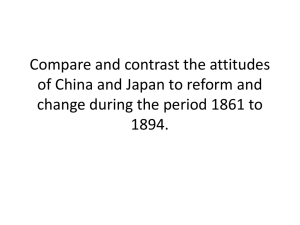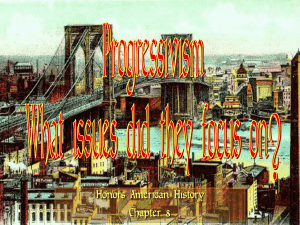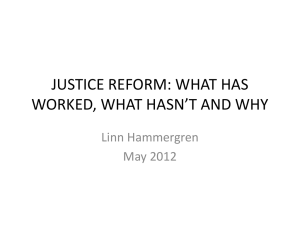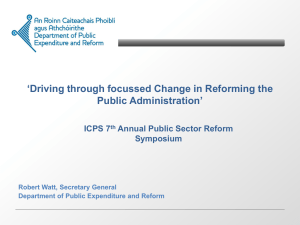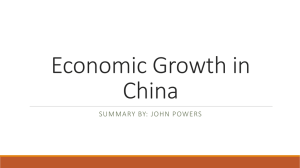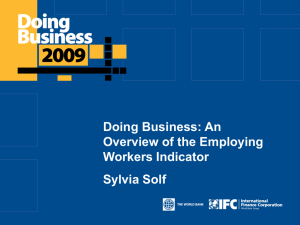Priorities for reform - Victorian Competition and Efficiency Commission
advertisement
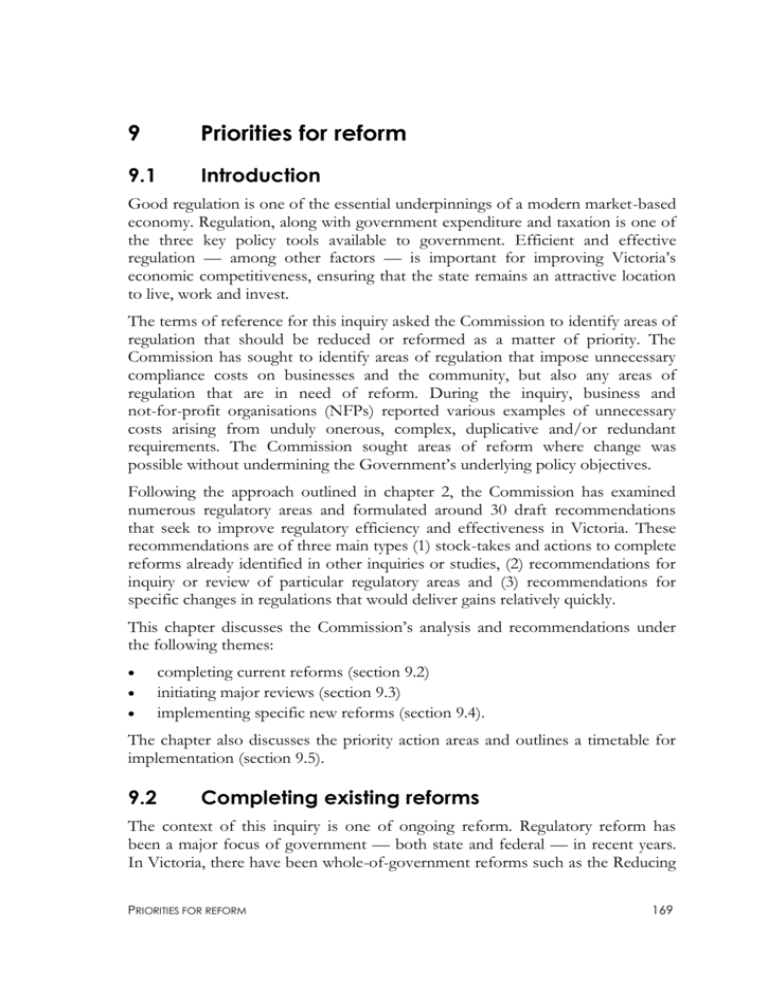
9 Priorities for reform 9.1 Introduction Good regulation is one of the essential underpinnings of a modern market-based economy. Regulation, along with government expenditure and taxation is one of the three key policy tools available to government. Efficient and effective regulation — among other factors — is important for improving Victoria’s economic competitiveness, ensuring that the state remains an attractive location to live, work and invest. The terms of reference for this inquiry asked the Commission to identify areas of regulation that should be reduced or reformed as a matter of priority. The Commission has sought to identify areas of regulation that impose unnecessary compliance costs on businesses and the community, but also any areas of regulation that are in need of reform. During the inquiry, business and not-for-profit organisations (NFPs) reported various examples of unnecessary costs arising from unduly onerous, complex, duplicative and/or redundant requirements. The Commission sought areas of reform where change was possible without undermining the Government’s underlying policy objectives. Following the approach outlined in chapter 2, the Commission has examined numerous regulatory areas and formulated around 30 draft recommendations that seek to improve regulatory efficiency and effectiveness in Victoria. These recommendations are of three main types (1) stock-takes and actions to complete reforms already identified in other inquiries or studies, (2) recommendations for inquiry or review of particular regulatory areas and (3) recommendations for specific changes in regulations that would deliver gains relatively quickly. This chapter discusses the Commission’s analysis and recommendations under the following themes: completing current reforms (section 9.2) initiating major reviews (section 9.3) implementing specific new reforms (section 9.4). The chapter also discusses the priority action areas and outlines a timetable for implementation (section 9.5). 9.2 Completing existing reforms The context of this inquiry is one of ongoing reform. Regulatory reform has been a major focus of government — both state and federal — in recent years. In Victoria, there have been whole-of-government reforms such as the Reducing PRIORITIES FOR REFORM 169 the Regulatory Burden (RRB) Initiative as well as reform of specific regulatory areas. Significant progress has been made in reducing regulatory burdens on business; many departments and agencies have reported administrative cost saving to business as part of the RRB Initiative — estimated at about $246 million a year, based on current initiatives (DTF 2010b, p. 12). There have also been numerous reviews or public inquiries into different areas of Victorian regulation by bodies such as the VCEC, the State Services Authority, and numerous taskforces or expert committees. Some Commonwealth and national regulatory reviews are also relevant to Victorian regulation. However, a major theme emerging from this inquiry is that of slow and uncompleted reform. Despite many of the recommendations from these inquiries and reviews being supported by the former Government, a substantial number have not been translated into action or have been implemented only in part. For example: In the area of environmental regulation, the extent to which government decisions on the VCEC’s recommendations on native vegetation have been implemented is unclear. This is also the case for government decisions relating to some other VCEC inquiries, such as that on the sharing of government and community facilities. In the area of NFP regulation, there have been numerous reviews at the state and Commonwealth levels, but there are perceptions that the implementation of reforms in some areas — particularly at the national level — has been slow. In the area of workers’ compensation and occupational health and safety (OHS) regulation, some reforms are yet to be implemented. The decision on changing the formula used to determine contribution fees for self insurers in Victoria has been deferred, despite the issue having been examined by several inquiries and reviews. In addition, action to reduce some duplication between Commonwealth and state agencies in the area of OHS regulation is yet to occur. Several of the Commission’s draft recommendations are intended to accelerate the pace and implementation of existing regulatory reforms. The Government should urge departments to prepare implementation statements for recent and future reports after two years. The Commission has proposed that for the Commission’s previous inquiry into environmental regulation, the Government produce a progress report on the implementation status of recommendations that it supported. This will enhance accountability and help realise the gains from reform more quickly. In the area of NFP regulation, the Commission sees an important role for the Office for the Community Sector as a facilitator of reform. 170 PRIORITIES FOR REGULATORY REFORM As a final safeguard, post implementation reviews should identify any existing reforms that have not been implemented. 9.3 Initiating major new reviews As well as the lack of progress in implementing existing reforms, there is evidence that new reforms are required in several key areas of regulation: In the area of education and training, there is substantial evidence of unnecessary regulatory burdens being imposed on Technical and Further Education (TAFE) institutes. These organisations appear to face onerous and duplicative reporting, data collection and auditing requirements. There appears to be potential for significant cost savings from simplifying current arrangements. In road and transport regulation, major reform of the taxi-cab industry is long overdue. The industry is afflicted by a range of serious problems which adversely affect its performance including the availability and quality of services. There have been numerous piecemeal changes to liquor control regulation in recent years which cast doubt on the coherence of the overall regulatory approach. Incidents of alcohol-fuelled violence and public disorder detract from community amenity, but can also disproportionately impact on community and international perceptions of public safety in Victoria. The Commission’s draft recommendation is to review liquor control legislation and it has sought comment on whether a wider review is appropriate. In the environment regulation area, there have been numerous state and national initiatives (such as energy efficiency, renewable energy and solar energy targets), raising questions over the necessity, effectiveness and interaction of these measures. These need to be reconsidered in the context of the Commonwealth proposing to introduce carbon pricing legislation. The Commission has proposed an independent review of state-based climate change legislation and regulation. In the area of planning, substantial reform and regulatory change is currently underway. The Commission considers, however, that it would be timely to take stock of the totality of review and reform work. It is, therefore, proposing to recommend that the Victorian Government publish a progress report on work underway to reform the planning system. Consequently, the Commission has proposed recommending reviews or inquiries into these key areas of regulation. Although there have been important steps towards risk-based regulation in some areas of regulation (for example, the risk-based classification of food premises, risk-based liquor licence fees, and EPA Victoria’s recent review of compliance PRIORITIES FOR REFORM 171 and enforcement), there appears to be scope to strengthen risk-based approaches in these and other areas of regulation. For example, the definition of ‘high risk’ licensed liquor premises used to apply certain licence conditions could be reviewed. There also appears to be potential for greater application of risk-based compliance and enforcement strategies, such as in the TAFE sector and the residential tenancy market. The reviews and inquiries that the Commission has proposed in this report are an opportunity to explore the appropriateness of risk-based approaches in these areas of regulation. 9.4 Implementing specific new reforms In addition to the major reviews or inquiries noted above, the Commission has formulated a number of draft recommendations of a more specific nature. These are outlined in table 9.1. Many of these are capable of implementation and delivering gains in the short term. Table 9.1 Specific reforms in various areas of regulation Regulatory area Draft recommendation Health & food safety Department of Health to develop a Memorandum of Understanding with the Commonwealth Department of Health and Ageing that formalises processes for cooperation that result in aged care providers only needing to report infectious disease outbreaks to one organisation and remove any duplication in inspections and reporting for health and safety standards. Environment & land use Appropriate landfill levies to be assessed by the Essential Services Commission. Simplify Authority to Control Wildlife (ACTW) processes, and allow limited commercial use of kangaroos and wallabies culled under ACTW. OHS & workers’ compensation WorkSafe Victoria to develop a Memorandum of Understanding with the Commonwealth Aged Care Standards and Accreditation Agency that sets out protocols for sharing information on OHS matters. Essential Services Commission to review the formula used to determine the contribution fees paid by self insurers in Victoria. Department of Treasury and Finance to examine key options to address inconsistencies in workers’ compensation schemes in Australia to determine which option would be of most (net) benefit to Victoria. Social regulation Victorian Government to renew the Office for the Community Sector’s responsibility for implementing reforms to reduce the regulatory burden on NFPs in Victoria, and to extend its responsibility to advising the Government on national consistency issues regarding NFP regulation. Tenancy & fair trading Department of Justice to review the Residential Tenancies Act and related regulations. (continued next page) 172 PRIORITIES FOR REGULATORY REFORM Table 9.1 Specific reforms in various areas of regulation (continued) Regulatory area Draft recommendation Victorian Government to remove statutory requirements for landlords to notify the Small Business Commissioner of new or renewed retail leases and for the Commissioner to maintain an information register of these notifications. An interdepartmental committee, chaired by the Department of Justice, to identify and examine fair trading provisions and cross references to the Fair Trading Act in industry-specific legislation to establish whether these provisions are necessary. Victorian Government to amend motor car traders legislation to reduce the requirement to retain documents to a minimum of 5 years from the date of their creation. Across multiple areas Department of Business and Innovation to examine key options, including that of a centralised licensing system, to improve online interaction between businesses/NFPs and Victorian regulators. Victorian Government to require Victorian regulators that do not currently have the facility for online lodgement of application forms and payment of licence fees to examine the case for doing so. Victorian Government to amend the Monetary Units Act 2004 to allow a fee unit to be expressed as a decimal when specifying a fee under 1 fee unit. Victorian Government to publish progress reports for VCEC final reports. Source: VCEC. 9.5 Reform priorities and timetable As a result of this analysis, the Commission has developed about 30 draft recommendations across a diverse range of regulatory areas. In addition, the report contains a large number of information requests which — subject to the information received — could ultimately lead to further recommendations. Taken as a whole, the current draft recommendations would constitute a significant regulatory reform agenda which could not all be actioned immediately. As noted in chapter 2, to prioritise the regulatory areas, the Commission considered each area against four criteria: the size of the regulatory burden, and the potential benefit to competitiveness, productivity and liveability over the short and long term from addressing the area the capacity for improvement without compromising policy objectives PRIORITIES FOR REFORM 173 the extent to which the issues are well understood and the need for action is clear the policy environment is changing substantially and existing regulation is likely to be obsolete or obsolescent. Based on these criteria, the Commission considers that the areas of highest priority are: (1) (2) (3) (4) (5) environment protection and climate change planning and land use regulation vocational education and training regulation taxi cab and hire car services regulation liquor licensing regulation. The Commission also considers that, in addition to these five priority areas, there are other areas that could potentially be included in the list but which require more research and analysis. These potential priority areas are: occupational health and safety and workers’ compensation administration of state taxes and charges road safety regulation fair trading regulation. The Commission also considers it important for the Victorian Government to put in place processes for accurately tracking the implementation progress of actions already put in place. This priority list does not imply that the other draft recommendations in this report are unimportant. In responding to the Commission’s final recommendations the Victorian Government should develop an implementation program outlining actions and timeframes to ensure that all the recommendations are eventually implemented. 9.5.1 A timetable to focus efforts Dealing with the four priority areas identified above would involve a combination of specific actions and additional reviews. The Commission considers that there is a time path over which burden reductions will be achieved. Some can be undertaken almost immediately, while others, such as where additional reviews are required, can be initiated relatively quickly but the ultimate burden reductions may not occur for some time — possibly several years. 174 PRIORITIES FOR REGULATORY REFORM Priority action area 1: Take stock and implement existing reforms The Commission considers that there is substantial benefits to be achieved by implementing the many reforms that have already been identified. There is a significant task to take stock of and complete implementation of existing reforms. This is expected to particularly reduce the regulatory burden in the following key areas of regulation: environmental regulation NFP regulation reform of the planning system. The Commission considers that the gains — in terms of reducing regulatory burdens — from taking stock and implementing existing reform will start to be realised in the short term. Priority action area 2: Initiate major reviews Initiate major reviews of identified areas of Victorian regulation; that is: TAFEs and their regulation taxi cab and hire car industry and its regulation liquor industry and its regulation climate change initiatives. The gains from any new reforms stemming from these major reviews will take longer to accrue because the reviews may take up to a year or even longer to complete and the Government needs to consider the proposed reforms. This timeframe makes it important to commence these reviews as quickly as practicable. Priority action area 3: Implement specific reforms As part of its analysis, the Commission has identified a range of specific reforms that, once implemented, will reduce regulatory burdens faced by businesses. The Victorian Government should implement specific new reforms recommended by the Commission. The gains from specific new reforms will start to be realised in the short term. PRIORITIES FOR REFORM 175 176 PRIORITIES FOR REGULATORY REFORM

